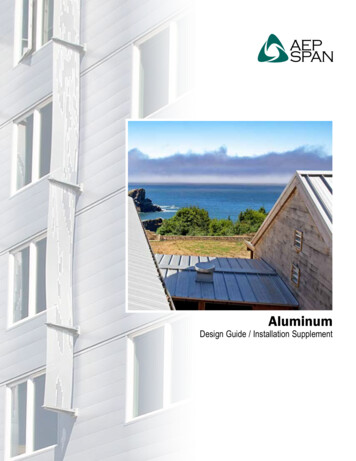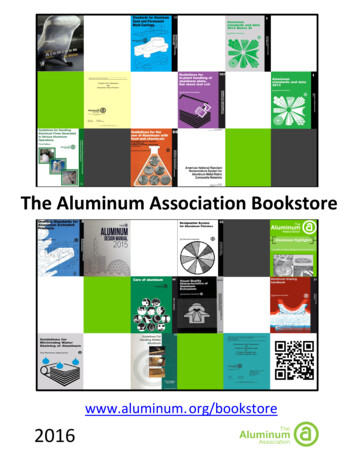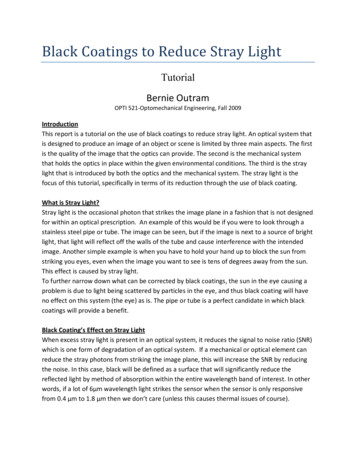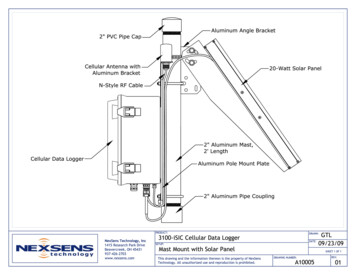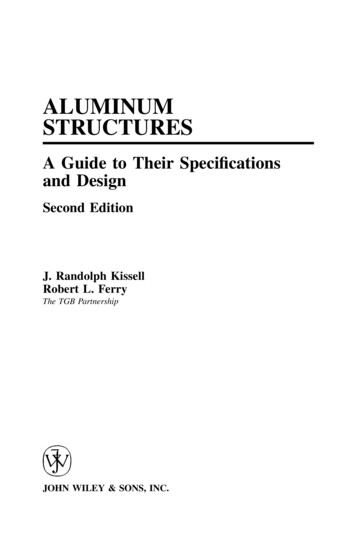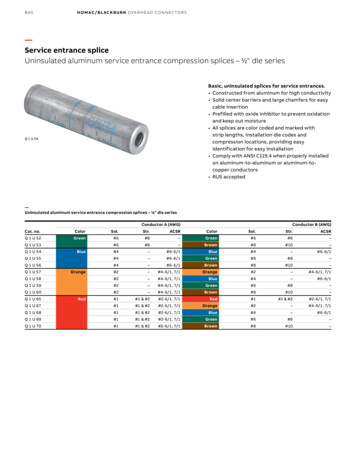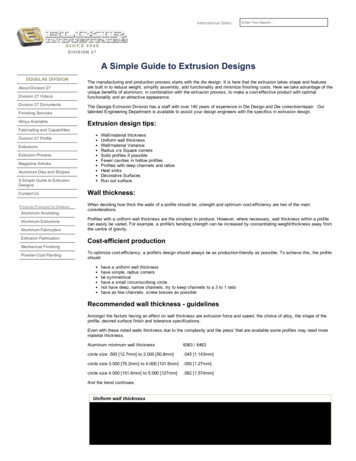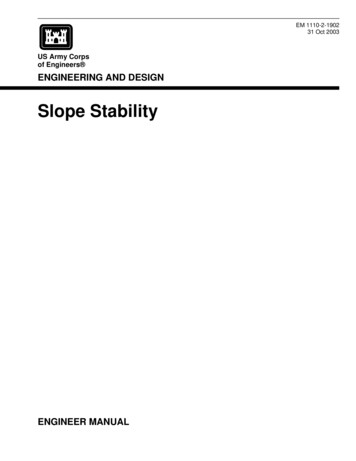
Transcription
Form and Stability ofAluminum Hydroxide Complexesin Dilute SolutionGEOLOGICAL SURVEY WATER-SUPPLY PAPER1827-A
Form and Stability ofAluminum Hydroxide Complexesin Dilute SolutionBy J. D. HEM and C. E. ROBERSONCHEMISTRY OF ALUMINUM IN NATURAL ination of the effect of pH onaluminum solubility and the determinationof the composition of complexes most likelyto occur in natural waterUNITED STATES GOVERNMENT PRINTING OFFICE, WASHINGTON : 1967
UNITED STATES DEPARTMENT OF THE INTEFIORSTEWART L. UDALL, SecretaryGEOLOGICAL SURVEYWilliam T. Pecora, DirectorFor sale by the Superintendent of Documents, U.S. Government Printing OfficeWashington, D.C. 20402 - Price 25 cents (paper cover)
CONTENTSPageAbstractPurpose and scope.Acknowledgments.Previous studies.Dissolved and suspended species .Nature of precipitated solids, ----- - - - --- -Structures of aqueous aluminum speciesHydrolysis experiments.--.-- - . -- -- -Behavior of anionic aluminum species.Behavior of cationic aluminum species.Potentiometric measurements. - - - - - - -Measurement and significance of aluminum concentrationsFiltration experiments. ---- -- - -- - -Characteristics of filterable material-- - -- . -Structure of aluminum hydroxide polymers.Mechanisms of polymerization. - -- ---Verification of polymeric structure.Electron microscopy. -- -- -- - . -- -Reaction-rate studiesInterpretation of results of rate studies. ---- --Direct determination of unpolymerized aluminum. .Replacement of hydroxide by fluoride ions - - - -Calculation of aluminum hydroxide solubility.Calculation of *Ki --- -- -- - -- --- Factors controlling pHSummary and conclusions.Application to natural conditions.Literature cited. - ---- . ----- 53
IVCONTENTSILLUSTRATIONSPageFIGURE1. Schematic representation of hydrolyzed aluminum ionA1(OH2) 6 3---------------------------------- -----2. Schematic representation of dimeric cationA12 (OH) 2 (OH2) 8 *.-- - - ---- --3-7. Graphs showing:3. Typical titration curves.4. Observed solubilities of aluminum anionic species.5. Ratio r (COH CAI )) versus pH -------6. Decline of pH with time for three solutions7. Percentage of aluminum remaining in solut:ons8. Schematic representation of possible linkages of aluminumhydroxide dimers9. Graph showing molar ratio of structural OH to ccmplexedaluminum.10. Schematic representation of ring structure formed by sixaluminum hydroxide octahedra.11. Schematic representation of network of aluminum hydroxide octahedra ------- - -- -- -12. Electron photomicrograph of microcrystallinegibbs;te.13. Graph showing rate of reaction of freshly formed aluminumhydroxide. --- ---- -- - - - -14. Graph showing rates of reaction of aged aluminum hydroxide. -------- -- - - --- - -- -15. Graph showing solubility of 03134373847TABLESTABLE 1. Free energies and stability constants.2. Determination of stability constant for freshly precipitatedaluminum hydroxide.- ------ - - - - - -3. Determination of stability constant for aged aluminuir hydroxide (bayerite) - ------- - - - --- - - - --------4. Percentage of aluminum hydroxide in filterable state in agedsolutions.5. Reaction rates of aluminum hydroxide polymer at pH 2.88 inrelation to aging time . - - - --- ---6. Form of bound hydroxide deduced from rates of dissolution ofaluminum hydroxide polymers and related species.7. Rapidly reacting aluminum determined by ferron comparedwith calculated values for A1 3 and A10H 2 --- -- -----8. Computation of *K\,PageA918182536404349
CHEMISTRY OF ALUMINUM IN NATURAL WATERFORM AND STABILITY OF ALUMINUM HYDROXIDECOMPLEXES IN DILUTE SOLUTIONBy J. D. HEM and C. E. ROBERSONABSTRACTLaboratory studies of solutions 4.53X 10 4 to 4.5X 10 5 molal (12.2-1.2 ppm)in aluminum, in 0.01 molal sodium perchlorate, were conducted to obtain information as to the probable behavior of aluminum in natural water. When the solutions were brought to pH 7.5-9.5 and allowed to stand for 24 hours, a precipitate was obtained which was virtually amorphous as shown by X-rays, and whichhad a solubility equivalent to that of boehmite. This precipitate had a hydrolysis constant (*jK"S4) of 1.93X1Q-13. When solutions were allowed to str-nd atthis pH range for 10 days, their precipitates gave the X-ray pattern of br.yerite(*X"s4 l.llX 10 4). These hydrolysis constants were obtained at 25 C. ard corrected to zero ionic strength and are in close agreement with other pul Tishedvalues. The predominant dissolved form in this pH range is A1(OH) 4 .Below neutral pH (7.0) the dissolved aluminum species consist of octahedralunits in which each aluminum ion is surrounded by six water molecules or hydroxide ions. Single units such as A1(OH2)6 3 and AlOH(OH2)5 2are most abundant below pH 5.0, and where the molar ratio (r) of combined hydroxide to totaldissolved aluminum is low. When r is greater than 1.0, polymerization of theoctahedral units occurs. When r is between 2.0 and 3.0, solutions aged for 10days or more contained colloidal particles between 0.10 and 0.45 p in diameter.Particles whose diameters were greater than 0.10 M were identified by X-ray diffraction as gibbsite. Particles smaller than 0.10 were also present and wereshown by means of the electron microscope to have a hexagonal crystal pattern.Structured material consisting of sheets of coalesced six-membered rings of aluminum ions held together by double OH bridges has a distinctive kinetic bel avior.This property was used to determine amounts of polymerized material in solutionshaving r between 1.0 and 3.0 after aging times ranging from a few hours to morethan 4 months. Aging increased the size and orderliness of the polymeric aggregates and was accompanied by a decrease in the pH of the solution.The kinetic experiments and stoichiometric data for solutions aged for long periods provided a means of determining activities of unpolymerized aluminum.From these values the solubility product for microcrystalline gibbsite was determined to be 2.24X10- 33, and its free energy of formation, 272.3 0.4 kcal permole.Al
A2CHEMISTRY OF ALUMINUM IN NATURAL WATERWhere polymerization was observed, the process did not stop with small polynuclear complexes containing a few aluminum ions, but proceeded with aginguntil macromolecules or colloidal-sized particles were formed.PURPOSE AND SCOPEAluminum is an abundant constituent of rock minerals; in fact,only oxygen and silicon exceed aluminum in abundance among theelements present in the outer part of the earth's crust. Aluminumis, however, a very minor dissolved constituent in natural water.In routine water analyses the element is seldom determined, but theavailable information shows that, except for waters having a pH below4.0, concentrations rarely exceed a few tenths of a part per million.The chemistry of aluminum in rock-weathering processes seems tofavor retention of the element in solids with low solubilities, especiallyin clay minerals.Aluminum has a particularly strong tendency to hydrolize insolution, and at any pH above 3.5 various combinations of aluminumwith hydroxide ions occur.The purpose of this investigation was to determine the effect of pHon aluminum solubility and to determine the composition of aluminumhydroxide complexes that are most likely to occur in solution orsuspension in natural water. The equilibrium stability of thesespecies, their geometric configuration, and the kinetics of reactions inwhich they are destroyed were also considered.ACKNOWLEDGMENTSDuring this investigation the many discussions held with colleaguesin the U.S. Geological Survey and with others having an interest inthe chemistry of aluminum aided in forming the conclusions expressedhere. Ivan Barnes and Robert Schoen, of the U.S. Geological Survey,and Dr. George A. Parks, of Stanford University, reviewed the manuscript. Robert Heidel, of the U.S. Geological Survey, aided in theelectron-microscope studies.PREVIOUS STUDIESThe solubility of aluminum hydroxide in water and the form andstability of solute species containing aluminum and hydroxide havebeen the subject of many research studies from early in the 20thcentury to the present. The stability constants published priorto 1961 are included in the compilation of stability constants bySillen and Martell (1964). The published work was reviewed carefully, with particular attention to the studies completed in the past10-15 years, to provide background information and to aic1 in planningthis investigation.
ALUMINUM HYDROXIDE COMPLEXESA3The results of previous investigations suggest that several differentforms of dissolved aluminum species might be expected over the pHrange most prevalent in natural waters. Stability constants reportedfor these species cover a rather wide range of values. The publishedstandard free-energy values for the common solid forms of aluminumhydroxide also disagree.The chemical behavior of aluminum in dilute solutions presentssome serious experimental difficulties. Most reactions involvingaluminum and hydroxide proceed slowly at 25 C. Metastable solidspecies occur and equilibrium conditions are difficult to attain evenwhen long periods of time have been allowed for reactions to proceed.In many reported experiments, equilibrium probably was not obtained. Solid aluminum oxides and hydroxides form a number ofof crystalline structures that are chemically similar but differ insolubility; not all investigations ascertained the nature of the solidsinvolved. Experimental conditions temperature, concentration,and even rate of addition of reagents strongly influence the results.The accuracy of analytical methods for determining low concentrationsof aluminum is not particularly good (below 1.0 ppm, or 4X10 5molar). Furthermore, aluminum hydroxide tends to form colloidalor subcolloidal suspensions that are difficult to describe thermodynamically.DISSOLVED AND SUSPENDED SPECIESPublished studies are in general agreement that when the pH ofa solution containing Al 3 ions is raised, dissolved species consistingof associated Al 3 and OH are formed, and that when the supply ofOH is sufficient, a precipitate of the composition A1(OH) 3 is produced.If the pH is further increased, this precipitate is redissolved as ananion having more than three hydroxide groups per aluminum.The details of the processes have been described in various ways.Although it is generally assumed that A1 3 ions are hydrated, thecoordinated water molecules are not usually shown in representationsof solution complexes.In early investigations, the association of aluminum and hydroxidewas assumed to be a mononuclear process occurring in steps. Thefirst ion to form would be A1OH 2. As pH increased, A1(OH) 2 would become increasingly abundant. A solid A1(OH) 3 would separate as pH increased, and then would be partly redissolved gs theanion A1(OH) 4 . However, stability constants generally wereobtained only for the species A1OH 2 and A1(OH) 4 and fo thecrystalline solid.In recent years, polynuclear complexes have frequently beenpostulated, with more than one metal atom in the simplest possiblerepresentation of the formula of the complex. The ratio of hydrox-
A4CHEMISTRY OF ALUMINUM IN NATURAL WATERide ions to aluminum ions in the complex species needs not be integral.Most recent work has shown that polymeric aluminum hydroxidespecies which have OH:A1 ratios less than 3.0 exist below pH 7.0.Although polymeric anions with an OH:A1 ratio a littl 0. below 4 inalkaline solutions have been reported, the univalent anion has beenassigned the composition A1(OH) 4 in most investigations, A1(OH) 4 is the form that will be used in this discussion. In some studies thenotations A1O 2 or H 2A1O 3 (Deltombe and Pourbaix, 1956) havebeen used to represent the removal of two molecules or of one molecule of water, respectively. Because of the strong tendency forhydration of aluminum ions, these forms seem unrealistic and havenot been used in this report.Among the more recent studies in which the monomeric cationA1OH 2 was reported are those by Schofield and Taylor (1954), Frinkand Peech (1963), and Raupach (1963a, b, c). The concentrations ofaluminum studied ranged from 10 5 to 10 2 molar. Measurements ofpH were made by means of a glass electrode in solutions of aluminumchloride or perchlorate at various concentrations. For the equilibriumAl 3 H 2O AlOH 2 H the mass-law equation for the equilibrium constant is1[A10H 2][H ]rA1 31 [H2O] 'Average values for *K\ at 25 C, reported in these investigations, were10 4 -98 , 10-5 -02, and lO"5 -05 to 10 4 -97, respectively. Tm is excellentagreement and compares favorably with results of several earlierinvestigations cited in Sillen and Martell (1964). The lowest individual values of *Ki obtained by Frink and Peech and by Raupachwere those applicable to the most dilute solutions and we e about halfas great as the largest individual values.Dissolved aluminum species in which the OH:A1 ratio exceeds 1.0appear in solution as the pH increases. A second-step monomericassociation product, A1(OH) 2 , was reported by Gayer, Thompson,and Zajicek (1958), whose experimental technique involved preparinga solid A1(OH) 3 and reacting it in solutions of NaOH and HC1O 4 .The solubility product for this solid A1(OH) 3 was 1.10X1Q-33, and itsstandard free energy was 272.73 kcal per mole. Gayer, Thompson,and Zajicek did not obtain a constant value for the ionic product forA1OH 2. The average apparent equilibrium constant for the reactionAl(OH) 3 (c) H A1(OH) 2 H 2O
ALUMINUM HYDROXIDE COMPLEXESA5was reported as 2.52. Individual experimental values, however,varied considerably from this average.Other investigators have reported dimeric or polymeric aluminumions. Faucherre (1954) reported the cation A12 (OH) 2 4 in solutionswhere aluminum concentrations exceeded 1.1X10 2 molar; at concentrations below 5.1X10"3, however, the monomer A1OH 2 was predominant.Prof. L. G. Sillen and his associates studied polynuclear comDlexesextensively and published many papers on experimental, mathematical, and graphical techniques for determining the form and sis bilityof these complexes (Sillen, 1954a, b; Heitanen and Sillen, 1954). Ageneral discussion of the subject by Sillen (1959) presents results forvarious metals. Often the hydrolysis of an element can be explainedby assigning most or all the complexed form to a single polynuclearspecies or to a few such species. Some elements, however, se?m toform a considerable number of polynuclear species, which consist of aseries of complexes containing a fundamental unit (called by Sillenthe core) with a varying number of attached units (the links). Assuch structures increase in size and complexity, a greater and greaterdegree of analytical accuracy is needed in evaluating them. Polynuclear aluminum hydroxide species evidently are of such size thatthey become difficult to evaluate with certainty.Brosset (1952) made one of the most extensive experimentalstudies of the chemistry of aluminum hydrolysis. To speed thereactions, the work was done at 40 C. The experimental data wereinterpreted as indicating polynuclear complexes. The original datawere later reinterpreted by Brosset, Biedermann, and Sillen (1954) asindicating that either a single complex Al6 (OH)i5 3 or a series of complexes with the formula Al[(OH) 5Al2] n (3 n) was formed in acid solution.Brosset at first postulated a polymeric anion complex at pH levelsabove neutrality; but on recalculation from the data, Brosset,Biedermann, and Sillen (1954) concluded that the results could beexplained satisfactorily by postulating that only Al(OH) 3 (c) ard theanion A1(OH) 4 formed in alkaline solutions.The concept of the polynuclear type of complex does not imposeany limit on the number of metal atoms or hydroxide groups whichare bound together into a unit. Structures containing only a fewaluminum ions would obviously behave like other solute ions, and canbe so treated in calculations of activity and solubility. As thenumber of aluminum ions included in the complex increases, thestructural units become larger and larger until the system becomescolloidal and finally becomes a suspension of crystalline solid particles.The polynuclear structures appear to be transitional between thedissolved state and the solid state, and when such structures become247-417 O 67 i 2
A6CHEMISTRY OF ALUMINUM IN NATURAL WATERvery large they present difficulties in applying theoretical conceptsof activity of solutes and in calculating solubility.As Brosset and other investigators noted, the pH of a dilute solutionof aluminum ions may be raised by adding a base to provide an averageof 2.75 2.95 OH groups associated with each aluminum, and no solidwill appear to be present. The aluminum in the solutions, after asuitable aging period, is in an ordered state of combination withhydroxide which Brosset (1952, p. 934) stated could be "describedas a series of macromolecules with varying numbers of aluminumatoms. It cannot possess a well-defined activity in thi form, so theconcept oj solubility product will not apply in this case.' 1 The meaningof this statement is somewhat obscure, but apparently the intentwas to explain why solid aluminum hydroxide species were not takeninto account in interpreting the experimental data. Certainly, however, at some stage as larger and larger polymerized particles areformed, the polymer will begin to act as a solid rather than as a groupof charged solute ions. Just where this point is reached is uncertainbut highly polymerized aluminum hydroxide species certainly cannotbe expected to behave like simple ions.The aluminum hydroxide gels have been studied by means oflight-scattering and viscosity measurements. Ruff and Tyree (1958)calculated an average molecular weight for the aluminum hydroxidepolymer ranging from 256 when the OH:A1 ratio was 0.5, to 1,430when the ratio was 2.25. These solutions were aged for 6 months.Other investigators, using many different methods, bave assignedvarious formulas to the species of hydroxide polymer they believed tobe predominant. Matijevic, Mathai, Ottewill, and Firker (1961)concluded from experiments involving the coagulation of silver halidesols by means of hydrolyzed aluminum solutions, that the formulaA18(OH) 20 4 could be used to represent the first hydrolysis product.Hsu and Bates (1964) suggested a fundamental structure ofA16(OH) 12 6 representing a six-membered ring of aluminum ions connected by double OH bridges. Johanssen (1963), from studies of hydroxosulfates of aluminum, described a basic unit of 13 aluminum ionsbound to hydroxide in a crystalline solid which formed so rapidlyfrom solution that it was postulated to exist as a unit in hydrolyzedaluminum solutions.From potentiometric titrations and infrared spectra Fripiat,Van Cauwelaert, and Bosnians (1965) proposed a general formulaAl[(OH) 8Al3] re4 for the polymer.All workers are in general agreement that the reaction? of aluminumand hydroxide in the pH range from 4.0 to 7.0 are slow and thatproducts formed may be influenced by concentration of reagents,
ALUMINUM HYDROXIDE COMPLEXESA7kinds of anions present, and the manner in which the solutiors areprepared. The disagreement of results is, therefore, understandable.Some investigators have preferred to consider the aluminumhydroxide polymers metastable forms which in time could b expected to become an Al(OH) 3(c) phase (Frink and Peech, 1963).The polymers, however, are so slow to change at the temperatureof most weathering environments that they must be given consideration in any evaluation of the chemical behavior of dilute solutionsof aluminum in natural systems.The literature describing the behavior of aluminum in alkalinesolutions is in somewhat better agreement. The anion A1(OF) 4 isgenerally specified. For the equilibriumAl(OH) 3(c) H20 A1(OH) 4- H the equilibrium constant *KSi was reported by Szabd, Csdnyi, andKavai (1955) to be lO"12 -74 at 20 C. The crystal structure of thesolid present was not reported, but because of the methods ueed inpreparation, the solid must have been a freshly precipitated fo m ofA1(OH) 3. Raupach (1963a) reported a value of l(r13 -84 for thisconstant at 25 C with a solid that had been aged long enough todevelop the crystal structure of bayerite, and Gayer, Thompson,and Zajicek (1958) reported a value of 10 14 -53 and X-ray diffrrctiondata for the precipitate. Feitknecht and Schindler (1963) laterconcluded that the X-ray data showed the solid to have been bayerite.NATTJBE OP PRECIPITATED SOLIDSDespite an extensive literature, many uncertainties exist as towhat solids might be formed under specific conditions of precipitation of A1(OH) 3, as the structure of the solids depends on pH,temperature, reagent concentration, and other experimental f&.ctorsinvolved in the procedure.Herbillion and Gastuche (1962) obtained a variety of crystalline andamorphous A1(OH)3 species whose form depended on pH, temperature, and time. Electron-microscope and X-ray studies of similarspecies reported by Papee, Tertian, and Biais (1958) indicated thatan amorphous gel was formed by rapid precipitation at the lowe pHthey used (pH 8.0). This was the least organized arrangement. Apseudo-boehmite gel was obtained at pH 9, and more crystallineproducts were obtained at increased pH, in the order pseudo-boehmite, bayerite, gibbsite. Other work in this field (see Fricke andMeyering, 1933) is not in complete agreement as to pH and otherconditions that might be expected to favor any given crystallinespecies. However, it seems reasonable to conclude that the slow
A8CHEMISTRY OF ALUMINUM IN NATURAL WATERdownward drift in pH observed in dilute solutions of Al 3 speciesnear pH 5, as reported by Frink and Peech (1963) and by Brosset(1952), indicates that a form of Al(OH) 3 having a rather low degreeof organization and stability forms in weakly acid conditions; andthat, on aging, this solid is slowly converted to more str.ble material.The precipitate first obtained in weakly alkaline solutions, on theother hand, is somewhat more crystalline and stable. This is indicated by the more stable pH observed by Brosset for sections at pH9.0 or 10.0 (1952, p. 922). Brosset pointed out this tendency, terming the least stable substance an "a-gel," which, on aging in a neutralor basic environment, passes to a "/3-gel" (pseudo-boehmite) andthence, on further aging, to boehmite which has the compositionA1OOH. Raupach (1963a) reported bayerite and gibbsite to be themost stable substances in alkaline solutions, and amorphous A1(OH) 3and corundum, in acid solutions.Solubility measurements are generally made at an assumed equilibrium condition, in a heterogenous system. True solubility datarequire equilibrium and exact knowledge of the thermod Tmamic characteristics of the phases. For aluminum this kind of knowledge islacking, and for some conditions, nearly impossible to attain.Table 1 contains selected free-energy values and stability constantswhich have been obtained from published work, and values obtainedin this investigation.STRUCTURES OF AQUEOUS ALUMINUM SPECIESThe aluminum ion is small and has a high charge, and thereforewhen dissolved in water it can be expected to be surrounded by atightly bound shell of oriented water molecules. The sizes of thealuminum ion and the water molecules are such that the aluminumwill lie at the center of an octahedron, at each vertex of which is awater molecule. In other words, the coordination number is six,at least for solutions whose pH is near or below neutrality. Theremay be some tendency toward a four-coordinated arrangement athigher pH; although this is not documented in the literature, thespecies A1(OH) 5 2 and A1(OH) 6 3 have not been reported.The innermost layer of water molecules will be arranged withtheir negative charge centers directed toward the aluminum ion andtheir positively charged sides, on which the two protons are located,facing outward. The strong charge on the aluminum ion tends toweaken the forces holding the protons to the oxygen, and thus theprotons are relatively easy to dislodge. The typical behavior ofaluminum demonstrates this fact, in that a low pH is required toprevent hydrolysis from taking place with the loss of one or moreprotons from the six adjacent water molecules.
ALUMINUM HYDROXIDE COMPLEXESA9TABLE 1. Free energies and stability constantsStandard free energyofformationSpeciesA1 3AlOH 2 - --- -------- Al(OH) 2 - -- Al(OH) 3 (c) amorphous.Al(OH) 3 (c) microcrystallinegibbsite.AlOOH(c) boehmite.Al(OH),(c) bayeriteAl(OH),(c) gibbsiteA1(OH) 4- --- - ----Equilibria-115.0-164.9-215.1-271.9-272. 3« -217.5-276.2-274.0-273.9-273. 5-277. 1-277. 3-313.9-311. 7-4. 98-5. 05-7.55-7. 07 . 06 17H . 34H .Al(OH) 3 (c) H 2O Al(OH),Latimer (1952).Raupach (1963a).Do.Latimer (1952).This report.Latimer (1952).Deltombe and Pourbaix (1956) .This report.Latimer (1952).Barany and Kelley (1961);Frink and Peech (1962).Raupach (1963a).Deltombe and Pourbaix (1956) .Raupach (1963a).This report.Log of equilibriumconstant-5.022A1 3 2H 2 O Alj(OH) 2 4 2H .Source of data, and remarks-97. 6» -12.746 -12. 71c - 13. 84c -13. 95Frink and Peech (1963).Schofield and Taylor (If 54).Raupach (1963b).Kentamaa (1955).Aveston (1965) ; determinedin 1 M NaClOi solution.Gayer, Thompson, andZajicek (1958).Sillen and Martell (1964);determined in ZM NaClOisolution.Sillen and Martell (1964);determined in ZM NaClOisolution.Szabo, Csdnyi, and Kavai(1955) at 20 C.This report.Raupach (1963a).This report.« Equivalent to 274.2 when calculated as Al(OH) 3.b Fresh precipitate.e Form of solid specified as bayerite.Figure 1 is a schematic representation of an aluminum-wateroctahedron. This unit structure upon undergoing the first step inhydrolysis by loss of a proton would become A1OH(OH2) 5 2 andwould change slightly in shape to allow the OH group to comesomewhat closer to the central aluminum ion than a water moleculecould. Two monomeric ions may coalesce to form the dimerA12 (OH) 2 (OH2)8 * by sharing the two OH ions and eliminating twowater molecules. This arrangement is shown schematically in figure 2. However, the shared edge should be a little shorter than anunshared edge, rather than the same length as shown. The two
A10CHEMISTRY OF ALUMINUM IN NATURAL WATERFIGURE 1. Schematic representation of hydrolyzed aluminum ion Al(OH2)e 3 .shared hydroxide ions form a double OH bridge connecting the twoaluminum ions, an arrangement which is also fundamental in thestructure of crystalline aluminum hydroxides. The length of theshared edge in basic aluminum sulfate was reported by Johansson(1963) to be 2.55 A.Pairs of octahedra in which all six positions are occupied by OH make up the structure of the crystalline aluminum hydroxides. Inthe transition of aqueous forms of aluminum to the crystalline stateit is to be expected that polymeric structures having patternsrelated to those of the solids will occur.The fundamental principles involved in forming these structures are:1. Aluminum ions are always surrounded by OH or by watermolecules.2. Changes in OH:A1 ratio occur by transfer of protons, not bymovement of OH .The stereochemical representation of aluminum hydroxide speciesin solution seems amply justified from theoretical considerations whichneed not be described hi detail here. The reasons for the strong tendency toward polymerization of the individual aluminum octahedra and
ALUMINUM HYDROXIDE COMPLEXESAllFIGURE 2. Schematic representation of dimeric cation A12 (OH) 2 (OH2)8 4 -the preference of the polymers thus formed for a planar or sheetstructure rather than a three-dimensional network lie in the preferential dkections in which Al-OH bonds are formed and in the r atureof the bonding forces. Mattock (1954), for example, pointed out thatthe tendency for metal ions to form polymeric hydroxides in solutionwas most pronounced when the metal-OH bond was partly covalent,but that the tendency disappeared both when the bonding was stronglyelectrostatic and when it was strongly covalent.HYDROLYSIS EXPERIMENTSPublished information does not provide adequate information fordeciding which aqueous species of aluminum are most likely to occurin natural water, what conditions govern the form of precipitatedaluminum hydroxide, or to what extent equilibrium conditions can beexpected to occur in dilute solutions of aluminum at various pH's.Laboratory studies were designed and carried out to furnish thenecessary basic data.The concentrations of aluminum in natural water are generally muchlower than those in solutions studied in most past investigations.Experimental difficulties, however, occur in work with these very lowconcentrations of aluminum. The maximum concentration selectedfor the laboratory experiments described here was 4.53X10"4 moles,equivalent to 12.2 ppm (parts per million) Al 3 . Experiments alsowere performed with solutions containing 1.2 ppm Al 3, and at
A12CHEMISTRY OF ALUMINUM IN NATURAL WATERintermediate concentrations. In solutions more dilute than 1.2 ppmthe sensitivity and precision of analytical procedures, the contamination due to solution of glass (Sackett and Arrhenius, 1962), and theimpurities in reagents tend to become critical. Results obtained inthe experiments can be extrapolated to the lower concentration rangesfound in natural water.Contact with glass could not be entirely avoided, but contamination from this source was held to a minimum. Polyethylene bottleswere used for solutions likely to attack glass and solutions that wereaged for long p
Free energies and stability constants._ A9 2. Determination of stability constant for freshly precipitated . The purpose of this investigation was to determine the effect of pH on aluminum solubility and to determine the composition of aluminum hydroxide c
